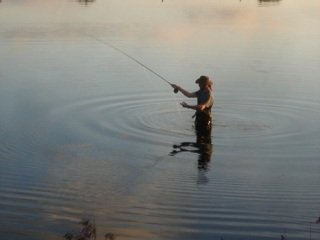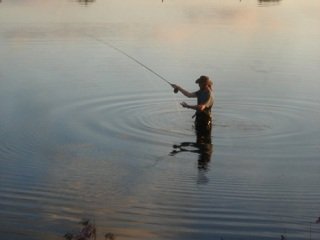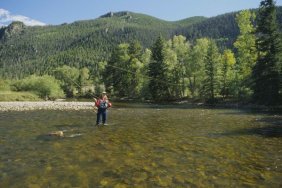 When some inexperienced anglers think of fly fishing, their thoughts turn to streams and trout. However, fly anglers are not limited to such locations or species and many seek out other fish, such as bluegill, pike, or bass. Fly rods tend to be more flexible and possess a lighter action that makes fly angling for bass a very exciting endeavor. It does require a focused approach to capitalize, however, and today I’ve highlighted a few tips to help you do just that.
When some inexperienced anglers think of fly fishing, their thoughts turn to streams and trout. However, fly anglers are not limited to such locations or species and many seek out other fish, such as bluegill, pike, or bass. Fly rods tend to be more flexible and possess a lighter action that makes fly angling for bass a very exciting endeavor. It does require a focused approach to capitalize, however, and today I’ve highlighted a few tips to help you do just that.
One of the most popular tactics for bass is fishing topwater, and fly angling for them is no different. A good deer hair or foam popper is a solid bet for bass on the fly, as these lure are not only effective, but exciting to use. When the waters are filled with vegetation, going topwater is a great way to avoid getting snagged. Furthermore, there’s just nothing quite like the explosion of a bass striking a topwater lure.
A good stop-and-go retrieve is the difference maker when it comes to using topwater flies for bass. Making your popper fly splash, chug, and plop is like ringing a dinner bell, and the tactic really allows for versatility on the water. You can adjust speed or intervals between twitches until you find what works. Often times, especially in shallow water or sight fishing, long pauses right after the cast are deadly. I suggest allowing the initial ripples to completely disappear before making a second twitch. This patient, methodical technique will aggravate bass to no end and excels at enticing them without spooking them with too much noise or movement.
While stumps, weed edges, and pockets are popular targets for popper flies, you can also cast towards open water, where drop offs lie beneath the surface. When the sun is high and fish dive deep, drop offs are where they reside and plugging a foam popper overhead will often times result in a strike especially from aggressive smallmouth.
When angling with topwater flies, a 9-foot, 9-weight fly rod is a smart option. The stiffer backbone is idea for topwater action and will get the fly out far, even in the wind. You’ll need to be sure to use floating fly line, as well, and also make sure it has a bass taper. For flies, use poppers made from deer hair, foam, cork, or even balsa wood. Each material performs differently, though, so having a variety is a good idea. Deer hair, for example, creates bubbles during the ascent after being popped, but needs to be dried out after a few casts. Choose your flies wisely and you should have no trouble.
Any angler can attest to the fun that accompanies topwater bass angling, but doing so on the fly is a whole different adventure. If you fancy yourself a fly fishermen and haven’t yet done so, pick up some bass poppers and head out to the lake this season. I guarantee you’ll be hooked in no time.








